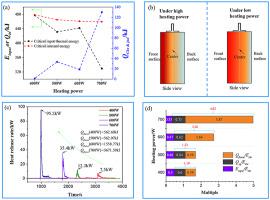Energy ( IF 9.0 ) Pub Date : 2021-08-26 , DOI: 10.1016/j.energy.2021.121885 Zonghou Huang 1 , Ting Shen 1 , Kaiqiang Jin 1 , Jinhua Sun 1 , Qingsong Wang 1

|
Overheat is one of the common safety issues for the large-scale application of lithium-ion batteries (LIBs), and is a potential risk that triggers thermal runaway (TR). In this work, the effects of the heating power and state of charge (SOC) on TR characteristics of large-format (Ni1/3Co1/3Mn1/3)O2 LIBs under overheat are investigated experimentally. The relationship between heating power, critical input thermal energy (Einput) and TR are identified firstly. The results show the Einput, critical internal energy, chemical heat and joule heat of batteries in critical TR state all decrease with increasing SOC. The heating power exhibits more significant impact on TR behavior than SOC dues to the rapid deterioration of TR as heating power ascends. The peak heat release rate of TR rises from 7.5 to 95.2 kW when heating power increases from 400 to 700 W. And the law the severity of TR deteriorates sharply with increasing heating power is more prominent in the TR propagation process. Besides, TR induced by higher heating power requires lower Einput. Einput decreases from 477.08 to 329.23 kJ as heating power ascends from 400 to 700 W. Furthermore, the relationship between internal short circuit and TR under different SOC and heating power are analyzed.
中文翻译:

加热功率对以Li(Ni1/3Co1/3Mn1/3)O2为正极的大型锂离子电池热失控特性的影响
过热是锂离子电池(LIB)大规模应用的常见安全问题之一,是引发热失控(TR)的潜在风险。在这项工作中,通过实验研究了加热功率和荷电状态(SOC)对大型(Ni 1/3 Co 1/3 Mn 1/3)O 2 LIBs 在过热情况下的TR 特性的影响。首先确定了加热功率、临界输入热能(E input)和TR之间的关系。结果显示E输入、临界内能、临界 TR 状态电池的化学热和焦耳热都随着 SOC 的增加而降低。由于随着加热功率的增加,TR 的迅速恶化,加热功率对 TR 行为的影响比 SOC 更显着。当加热功率从 400 W 增加到 700 W 时,TR 的峰值放热率从 7.5 kW 上升到 95.2 kW。并且在 TR 传播过程中,随着加热功率的增加,TR 的严重程度急剧恶化的规律更为突出。此外,由较高加热功率引起的 TR 需要较低的E输入。E输入 随着加热功率从 400 W 上升到 700 W,从 477.08 kJ 下降到 329.23 kJ。此外,分析了不同 SOC 和加热功率下内部短路与 TR 之间的关系。









































 京公网安备 11010802027423号
京公网安备 11010802027423号